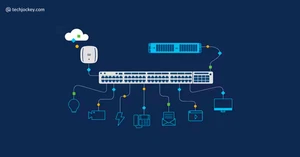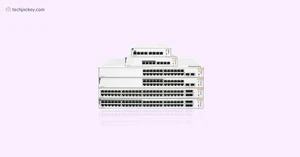What is LAN Switches Used for
LAN Switches are used to connect wired devices like laptops, servers, and routers to a local area network (LAN). A LAN switch box is used when you want to increase ports for your router. LAN switching method works best when you must communicate frequently to share common resources. These switches are used for:
- Better connectivity and access to multiple devices for communication in a network without straining individual devices
- Lower capital and operational expenditure with consolidated wiring
- Traffic monitoring and secure user access management for administrators
- Need-based bandwidth allocation decreases network degradation and downtime
- Rapid troubleshooting and higher security for the overall network.
How Do LAN Switches Work
LAN Switches work on the packet switching technique. The switches are connected to the nodes (devices) via ports.
In LAN switching, a switch establishes a connection between the sender and receiver till the current packet transfer is complete.
The traffic gets routed from the source to the destination via cut-through, store and forward, or fragment-free method. Most LAN switches combine cut-through with store and forward method to read and store the address, discard the packets with errors and send it to the destination only after checking for errors.
The basic process is as follows:
An Ethernet frame has a special header and a payload in the form of a packet. When one node sends data to another node, the switch gets the packet from the sender, reads its MAC address, and stores it in the lookup table.
Incoming packets in the Ethernet frame get stored in temporary memory. The entry in the lookup table gets deleted if there is no activity from a node for a certain amount of time.
The switch sends the packet to all segments that connect it to other nodes. The receiver node sends acknowledgment in the form of a packet.
Its MAC address is added to the lookup table and the packet is sent to the sender. If communication has already occurred, the LAN switch already knows the location of the node in the network.
The frame’s header which has the MAC address with the source and destination is read and compared to the lookup table in the switch.
For multicast purposes, the destination nodes can be grouped. There can be multiple segments to ensure that packet transmission does not fail but at a time, only one segment works.
How to Use LAN Switches
LAN Switches must be connected to the power supply and have access to the network. For LAN switching to work, you can set up their IP address as provided in their manual.
The modem needs to be first connected to the Ethernet input line and then to the router.
Then, attach the Ethernet cable to one of the switch ports. The other end can be connected to a wired device like a PC, laptop, or any other Ethernet device.
Now, connect one end of the Ethernet cable to a port located at the back of the LAN switch and the other end to one of the Ethernet ports at the back of the router. You can hard code the ports if needed. LAN switch box helps in increasing the number of ports for router connections.
Finally, connect the switch’s power port to the supplied power adapter which is connected to a power socket (not for PoE switches). For managed switches, you can make feature adjustments through the web interface, Simple Network Management Protocol (SNMP), or command-line interface.
How to Choose LAN Switches
You can consider the following factors while choosing LAN switches, keeping in mind your business requirements.
Speed: LAN switches offer varied port speeds, including 10GbE, 40GbE, and 100GbE. A fast ethernet switch transfers data packets at 10 Mbps while a Gigabit Ethernet (GbE) switch can be 100 times faster reaching as high as 1 Gbps. For LAN applications, users often prefer 10GbE switches.
A number of devices: Depending on the number of devices you want to connect to your network, the number of Ethernet ports required will also change. Your LAN ports in the switch must be sufficient to allow your network to grow easily.
Form factor: LAN switches come in different forms factors. You can choose based on the space it will occupy, noise reduction ability, and other similar parameters.
Management: Managed LAN switches offer several features including bandwidth management, access controls, troubleshooting, reporting, and more. Depending on your application, you can select LAN switches based on the set of features you require.
Safety standards and certifications: You must ensure environmental compliance, safety approvals, and other certifications for the LAN switches you choose.
LAN Switch Vs SAN Switch: Both aim to provide a data communication path but have significant differences.
| Parameter | LAN Switch | SAN Switch |
| Basis | Ethernet channel-based storage network | Fiber channel-based storage network |
| Method | Use of file-sharing protocol like CIFS & NFS | Use of iSCSI storage network |
| Cost | Low | High |
| Performance | Good with high transmission speed and low latency | Predictable |
| Storage capability | Less | More |
| Data security & integrity | Less, no guarantee | Good, guaranteed |
| Ability to manage heavy transaction loads | No | Yes |





























